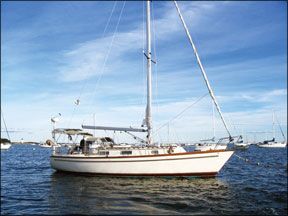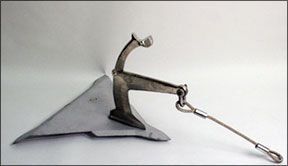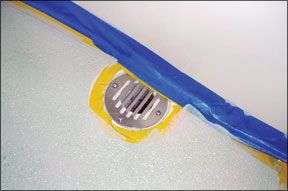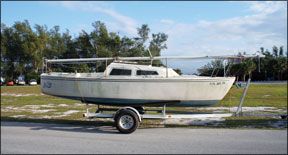Viva Lavac I read that you are going to review the Lavac head in the future. I have one on my Bristol Channel Cutter 28 and love it. A couple of things: Though the makers claim that the Lavac uses as little as 3 pints per flush, I use over 3 quarts. The Lavac manual suggests 13 to 16 strokes, which exceeds 1 gallon per flush. It will be interesting to see your results. Also, it is critical that the Henderson pump be mounted no less than 45 degrees from vertical. Otherwise, the simplicity and 288 reliability of the Lavac is terrific. It has managed some seriously challenging flushes without flinching. Tom Harrer
British Channel Cutter
Sister Bay, Wis.
According to Doug Moody of St. Brendans Isle, the U.S. distributor for the Lavac, the water usage figures are based on data from the manufacturer, and will vary greatly depending on installation. We will be evaluating this in our upcoming test of marine heads.
Tough Boat Club
Id like to add a boat to your list of strongly built fiberglass production boats: the Mariner 36. Mariners were made in the rugged farms of New Hampshire by builders who did not skimp on fiberglass or epoxy. Strong like bull!
There is anecdotal evidence that after being dragged onshore and uphill by hurricanes, Mariners were sailing again as soon as they were dragged back to the sea and the antifouling was touched up. Not the swiftest girl on the racing circuit, but you can’t beat the comfort or the 6 feet, 5 inches of headroom! A number have done the Newport-Bermuda race. There is an active owners group at http://p075.ezboard.com/Mariner-Yachts-Owners-Group/bmarineryachts.
Linos Dounias
Mattapoisett, Mass.
Tough Boat Too
Our 1970 Cal 34 has been part of our family for 23 of her 38 years. Her sailing resume includes: cruising the East Coast from the Bahamas to Newfoundland, Bermuda, and virtually every harbor in New England. Although not near as fast as her big sister, the Cal 40,
Killick has managed to gather a chest full of trophies.Her solid fiberglass hull, fully encapsulated lead keel, spade rudder, and plywood-cored decks make her truly bulletproof.
John & Nancy Berens
Shady Side, Md.
XYZ Fan
I just received the January issue and quickly turned to the Anchor Test Update. I have some comments to contribute regarding the XYZ anchor. In late 2005, we acquired
Maia, our Grand Banks 42, and found that we had consistent difficulty setting a 45-pound CQR. Our cruising grounds are the Chesapeake Bay-goo, soft mud, and some sand. After reading your 2006 review of the XYZ, we purchased a 14-pound prototype. We cruised extensively throughout 2006 and into 2007. We acquired the larger Extreme unit in mid-summer 2007. When backing down, the anchors set instantly, bringing our 34,000-pound vessel to a jerking halt every time
288
in light to extreme weather conditions. The anchors have never dragged or fouled on chain or rode. (One exception: the anchor impaled itself in a log.) If there is one drawback, it is the need for a powerful washdown pump! The anchors always come home carrying 10 to 20 pounds of muck.
David Lazarus
Bon Air, Va.
It is not surprising that the XYZ design would prove effective for your boat in the Chesapeake mud. Our tests also showed it to be effective in this type of bottom. We are closely watching the evolution of this design and look forward to testing the newest version, which is due for release this spring.
Rugged Nauta
I just read your analysis on the flexible tanks (October 2007). I have had the 13-gallon Nauta in my Compac 23/II since April 1984 and have been very pleased with it. Everyone who has sampled my water has said it tastes very good.
The boat is left out in the sun, snow, rain, and freezing cold, and the tank is still serviceable. The tank is kept fairly full the whole sailing season as it is necessary for the fore-aft balance of the boat. The tank is held in place with two screws in the forward two holes and attaches to the forward bulkhead. I put a piece of open-cell foam under it to pad it against the hull.
The Nauta distributors said I should have replaced the tank seven years ago, but it still looks new. Our boat has suffered two 90-degree knockdowns and has been thrown around in 6-foot seas. These actions havent been kind to the tank. I will buy another Nauta tank when the need arises.
Gordon Allison
Compac 23
Cleaner/Wax
Earlier this year, I made a purchasing decision for one-step cleaner/waxes based on your review of these products (and chose the Meguiar 50 Cleaner/Wax, which you gave high marks) in the March 2007 issue. Then in the November issue, you grade

288
this same product Fair for six months and Poor for the nine- and 12-month periods. Has this product changed that much to receive such poor ratings?
Tom Wales
Pemaquid, Md.
Because all of the cleaner/waxes in that test promised at least three months of protection in South Florida, we felt an initial report at that period was appropriate. At the time of that first March report, the Meguiar 50 stood out as one of the best products in the field-particularly on oxidized hulls-and its gloss was also very good until about the six-month mark. The Collinite, a top pick at three months, began to lose its gloss after 12 months. At last check (15 months), the Star brite Heavy Duty Cleaner Wax and the Re-Structure Marine were still beading water and holding gloss. Those willing to sacrifice some extra elbow grease for a longer-lasting finish should look for our upcoming test of heavy-duty waxes and hull restorers this year
.Electrical Tape Trim
A few issues back, you mentioned using electrical tape to tape off areas before painting or varnishing. When I recently set about to re-
apply gelcoat to the cockpit sole of my Tartan 3800, I was confronted with the need to tape off difficult inside curves. Bingo! I remembered your tip and tried the electrical tape-it worked perfectly!
Overall, it proved easier and faster to lay out, provided a clean line, and was easier to pull up when the project was done. Importantly, I don’t think I would have been able to tape these tight curves with blue masking tape. In the bargain, the cost of electrical tape is equivalent to that of masking tape, which your article mentioned. For long runs, however, it might be more difficult to run a straight line with electrical tape. Thanks for the tip.
Bill Solberg
Los Angeles, Calif.
Electrical tape used around hardware like stanchion bases works well, and its good tensile strength means it wont break off under epoxy and urethane paints. It does tend to leave an adhesive residue and is not as effective as high-grade “fine-line” masking tape when it comes to getting a fine, straight paint line.
Trailer Jacks
The article on trailer jacks was most informative. From experience, I would add one more capability to the general survey. That is the ability to change the jack from the caster/wheel option to a pad (or a different diameter caster/wheel) depending

288
on the need. My last trailer had a jack with both the wheel and pad option. You pulled the retaining pin, removed the piece that had been attached, and installed the alternate option. The “bury” of the piece being installed (and the clearance between the items inside the jack tube) was sufficient to hold the load. For road trips, you removed whichever piece was attached, giving you more ground clearance.
C. Henry Depew
Sisu 26
Tallahassee, Fla.
Which Catalina 22?
On your website, and in your 6th Edition of the “Practical Boat Buying Guide,” you have a lengthy review of the original Catalina 22 with price history updated as recent as 2002. The review is very accurate on many details of the boat (e.g. gas tank location, life lines, narrow side decks, winch handle location). Most Catalina 22 owners certainly will not disagree with the authors evaluation of these details.
However, it should be pointed out that the Catalina 22 you reviewed is one of the original Catalina 22s built from 1970 through 1985. Since 1985, the Catalina 22 has undergone three significant model changes, and another 4,000-plus hulls have been built: the original (1970-1985), the new design (when a wing keel became an option, 1986-1995), MKII (1995-present, $21,066), and Sport (2004-present). With a strong owners association, and many boats built since 1970, the Catalina 22 makes it possible for sailors, young and old, to find an inexpensive boat, to easily find parts and resources to fix it up, and be competitive and enjoy the fun of the sport. For those who do not wish to spend time fixing up an older boat, the availability of a new competitive boat, the Catalina 22 Sport, can also provide instant gratification.
Today, the C22 National Sailing Association (
www.catalina22.org) has a membership base of 850, and supports a balance of Catalina 22 owners who race and cruise. A big benefit of Catalina 22 ownership is the camaraderie and friendships that form over the years.Rich Fox, Commodore
C-22 National Sailing
Association
Our review of the Catalina 22, posted online under “Sample Boat Reviews” at
www.practical-sailor.com now makes it clear that the reviewed boat is indeed an original swing-keel model. We look forward to testing the newer models. Trailer-sailer owners may be interested to know that as a test project, we are restoring a 1974 Catalina 22, Jelly, a neglected boat that we bought last summer for $800-with trailer. Although the project has not brightened our view of the boats build quality, the work has been simplified thanks to the network of enthusiastic Catalina 22 owners. So far, weve spent about $1,000 on the project, most of it for upgrading the trailer. We are currently working with Sarasota, Fla., boatbuilder Robert Helmick as we make repairs to the keel and prep the hull for antifouling and topside painting. (Actual topside painting is pending results of our first round of topside paint testing, due in about 30 days.) We hope to have the boat sailing by the spring. So far, weve found nothing that a little fiberglass cloth and epoxy can’t fix, but the repairs would be frustrating for a novice. Stay tuned for updates.Where Is Metalmast?
When rebuilding my last boat, I used Metalmast Marine in Putnam, Conn., for numerous custom fabrications, from aluminum and stainless. Im starting a new project and tried to contact them with no luck. Their work was excellent, and their price was reasonable. Do you know what has happened to them? Are they out of business? Are there any other companies that perform the same type of services?
Barry W. Brown
Pearson Triton
Plymouth, Mass.
According to Dick Conti, the former manager of Metalmast, the company has shut down operations, but he and former engineer Claude DeBeauregard are now doing business as DCProducts. They are no longer fabricating masts, but they are doing mast consulting work and custom fabrication with stainless steel and aluminum. They can be reached by telephone at 860/908-9409 or by e-mail at dcproductsllc@yahoo.com.
Correction
The Tayana 37 specifications in the table on page 13 of the January issue were incorrect. The correct specifications appear on the website at
www.practical-sailor.com.






































